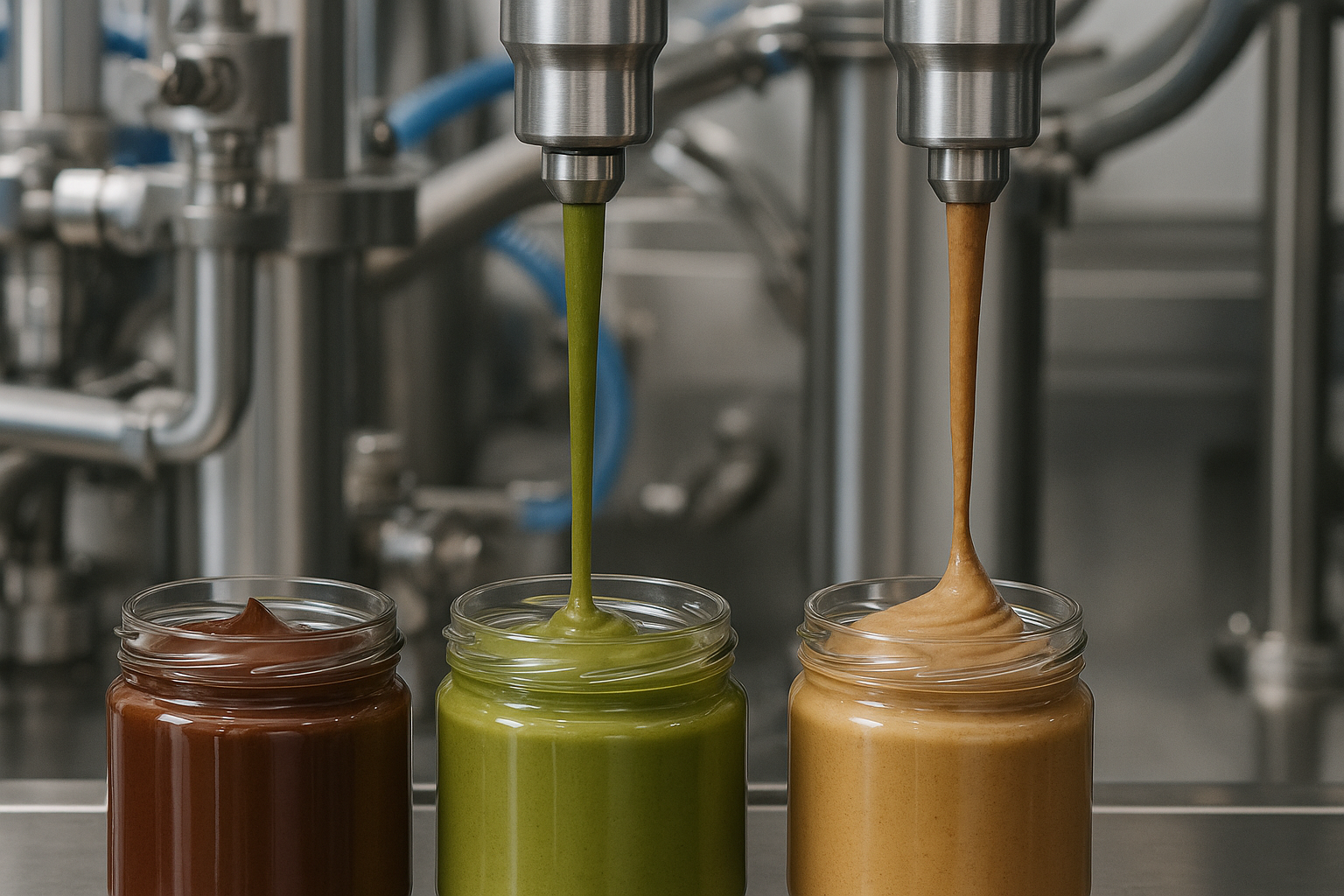The production of spreadable creams is a rapidly growing sector within the food industry, driven by the strong demand for indulgent and versatile products such as chocolate, pistachio, and peanut butter spreads, as well as vegan and protein-enriched variants. These creams are appreciated by consumers for their smooth texture and rich flavor, but their industrial-scale production requires sophisticated technologies and tightly controlled processes.
From raw material selection to packaging, every production stage affects the final quality of the product. In particular, filling high-viscosity products is a technical challenge that requires high-performance machinery capable of ensuring precision, hygiene, and consistency, even with dense and delicate mixtures.
The Spreadable Cream Production Process
The production of spreadable creams follows a well-defined sequence of steps that must be carefully managed to ensure a uniform, safe, and palatable finished product.
Ingredient Selection and Preparation
The process begins with the careful selection of raw materials: nuts (hazelnuts, pistachios, almonds), chocolate, sugar, vegetable oils, milk powder, thickeners, and functional ingredients like fiber or isolated proteins. Ingredients are cleaned and, in the case of nuts, roasted to enhance their aroma and prepare them for the next stages of processing.
Grinding and Refining
The solid ingredients are ground into a fine, creamy paste. This is typically done using ball mills or other specialized equipment that reduce particle size and release natural oils from the nuts, improving the mixture’s fluidity.
Tempering (if applicable)
If the recipe includes chocolate, a tempering process is required to ensure proper crystallization of cocoa butter. This step guarantees a smooth texture, consistent shine, and good shelf stability for the final product.
Homogenization and Further Refining
The resulting paste undergoes homogenization to fully unify the product’s structure, remove residual air bubbles, and ensure a stable and pleasant mouthfeel. This phase achieves the desired level of creaminess and ingredient cohesion.
Heating
Before filling, the cream is heated to lower its viscosity. Thermal control is critical: temperature fluctuations can alter density and affect dosing accuracy during packaging. Heating must be uniform and carefully regulated.
Filling
Filling is a key stage in the process. It requires machinery designed to handle high-viscosity products without introducing air or creating imperfections such as “tailing” (residual strings) or “overfilling.” Precision in this step directly affects product quality and production efficiency.
Sealing and Packaging
Once the containers—glass jars, plastic tubs, or other materials—are filled, they are sealed and packaged. Containers are hermetically closed, labeled, and prepared for distribution. Automating this entire process boosts productivity and maintains consistent quality standards.
Types of Spreadable Creams
The spreadable cream market is highly diverse and constantly evolving. Each type of cream has distinct chemical, physical, and rheological characteristics that must be considered when selecting production processes and equipment.
Among the main categories are traditional sweet creams, such as the popular hazelnut and cocoa spread, which combine sugar, vegetable oils, hazelnut paste, and natural flavorings. These are particularly popular with families for breakfast and snacks.
Another successful category is peanut butter, which is widely consumed in Anglo-Saxon countries. It has a denser, more granular consistency and a greater tendency to oxidize, which is why it is often packaged in a protective atmosphere.
In recent years, pistachio, almond, and mixed nut creams have gained popularity, often positioned within the gourmet and premium segments. These creams tend to be more expensive but offer a unique organoleptic profile and require careful processing to preserve natural flavor and color.
Protein-enriched, vegan, and sugar-free spreads are responding to the growing demand for healthier food products. These formulations include plant-based proteins, alternative sweeteners, non-hydrogenated oils, and functional ingredients, while still maintaining a creamy, spreadable texture. Organic spreads do not contain colorants, meaning they retain the natural color of the nut paste. For instance, pistachio paste naturally turns brown rather than bright green; achieving the latter requires added colorants.
Each type of cream poses different technical challenges during filling: viscosity can vary significantly, some creams require constant temperatures to prevent separation, and others are oxygen-sensitive and must be processed in controlled environments. For this reason, it is essential to use versatile, high-precision filling systems.
Machinery and Equipment for Spreadable Cream Production
Industrial spreadable cream production goes beyond simply mixing ingredients: it requires a cutting-edge technological infrastructure capable of ensuring consistent quality, food safety, and operational flexibility. In this context, selecting the right machinery is a fundamental competitive advantage.
The most advanced solutions available on the market today are designed to:
- Handle high-viscosity products smoothly and without interruption, even when inclusions (e.g., nut particles or fragments) are present.
- Maintain constant temperature during filling, avoiding fluctuations that could affect product structure or container distribution.
- Perform high-precision volumetric dosing, reducing the risk of overfilling (waste) and underfilling (non-compliance).
- Minimize air introduction into the product, preventing oxidation issues and extending shelf life.
- Facilitate sanitation, thanks to food-grade certified materials and hygienic-oriented designs that speed up cleaning between production batches.
- Quickly adapt to different container formats and dosing volumes, with optimized changeover times and user-friendly digital interfaces.
Integrating these systems into an automated line allows for optimized production flow, improved overall efficiency, reduced product loss, and consistent quality even at high volumes. Moreover, modular solutions make it easy to scale production or adapt to new recipes and variants, ensuring responsive adaptation to market changes.
In an increasingly competitive environment driven by product personalization, investing in versatile, intelligent, and high-precision equipment is essential to maintain high quality standards and ensure continuous, sustainable, and future-ready production.
